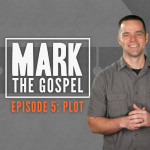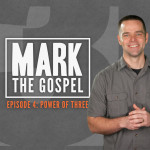It’s time to take a closer look at Mark’s arrangement of scenes! So throw out graphic divisions, like chapter and verse, as indications of the book’s plan and listen instead to what Mark says! Mark wrote specifically for hearers and weaves his organization into the very words of his story.
Let’s start by reading Mark 1:1-15. Hear any repeated words?
“Gospel” and or “good news”
“Messenger” or angelos in Greek, which is the same word for Angel.
Wilderness
The phrase “baptized by him (John) in the Jordan”
Spirit
Now consider where they occur!
The words in the first section are repeated in the last. And the ones in the second are repeated in a third. It’s A-B-B-A sequence. Though on the surface the story unfolds in a linear progression, the repetition creates an underlying pattern which packages these scenes together and, in turn, point to the start of a new unit.
Do you hear more repetitions in the scenes that follow? Mention of Jesus preaching in Galilee and the naming of Peter, Andrew, James and John? Where do they occur? Concentrically around Jesus’ ministry in the synagogue. It’s an A-B-C-B-A pattern. Once again, the echoes signal to a listening audience the units beginning and end.
Mark creates still a third sequence in the five stories after that. Echoes appear at the outer limits, in Jesus’ cleansing of the leper and his healing of the man with the withered hand. In both stories we find the phrase “stretched out his (your) hand” and the mention of Jesus becoming “angry.” Now most translations of Jesus encounter with the leper still say Jesus was moved with compassion. But the majority of scholars today have come to the conclusion that Mark originally said angry. And that incidentally finds a correspondence in the later scene when Jesus becomes angry at the religious leaders. Echoes within these five accounts also occur in the second and fourth stories, the story of Jesus forgiving the paralytic and the account of the disciples picking grain on the Sabbath. In both scenes, Jesus uniquely cites his authority as the Son of Man. Again these echoes appear concentrically around a center, Jesus’ calling of Levi, and are packaged together in A-B-C-B-A sequence.
Its here at the end of the third sequence where we encounter Mark’s inciting incident, the first indication of a plot to destroy Jesus. But Mark further emphasizes this narrative turn by packaging these three sequences together, revealing in this turn a termination to this larger unit.
We see this in the expressed parallels between the beginning of the first sequence and the end of the third. In chapter 3, Mark summarizes the effects of Jesus ministry, stating that people came from Judea, Jerusalem, Idumea, and the regions across the Jordan and around Tyre and Sidon. Three of these place names (Jerusalem, Judea, and Jordan) appear in a remarkably similar summary of the Baptist’s ministry at the beginning of the gospel, though we don’t hear them mentioned elsewhere together. And it’s here we find another parallel. Immediately before Mark introduces John the Baptist, he tells us that Jesus is “the Son of God.” A title which we’ve already seen is extremely significant though its only repeated three times in this form. The first is here in Mark 1:1 and the last, the centurion’s climatic statement in Mark 15. Which leaves the summary of Jesus’ ministry in Mark 3, as the only other instance. Which further suggests a connection between this summary and Mark’s beginning. Though these parallels, Mark has packaged these sequences together and brought this section to a close.
The termination of these three sequences simultaneous with the first mention of a plot to destroy Jesus marks this point as major turning in the narrative. In the next episode, we’ll explore where the turn leads and how Mark builds his story to the next major point.
See you then.


















